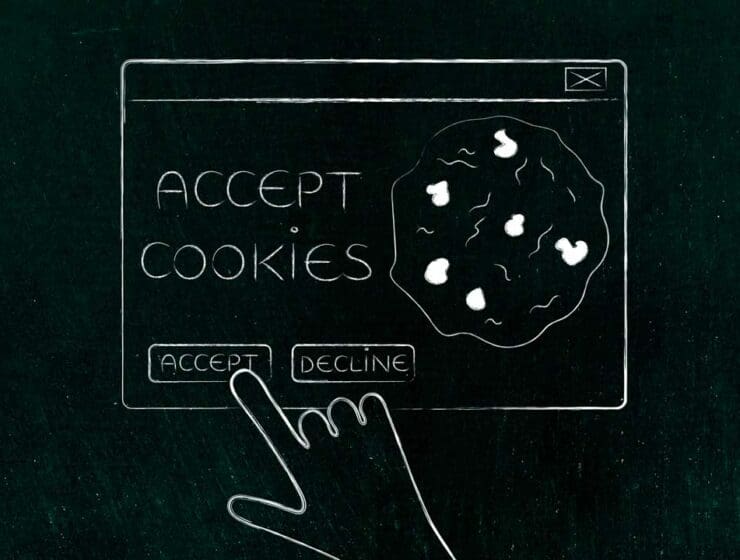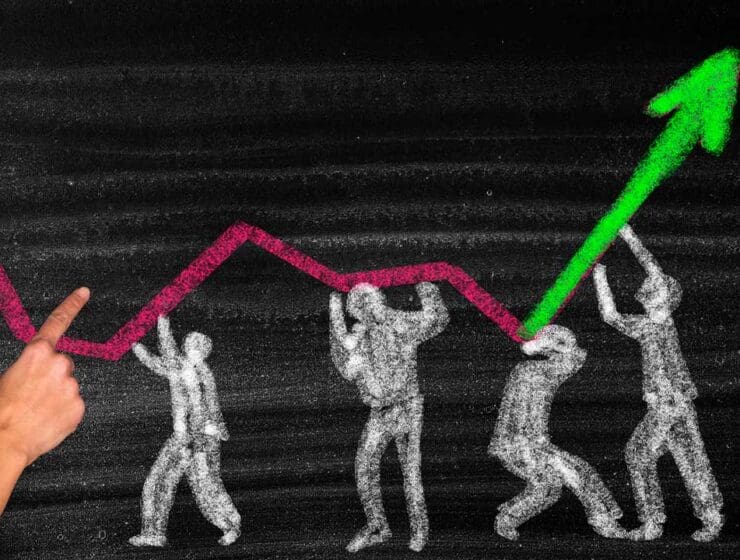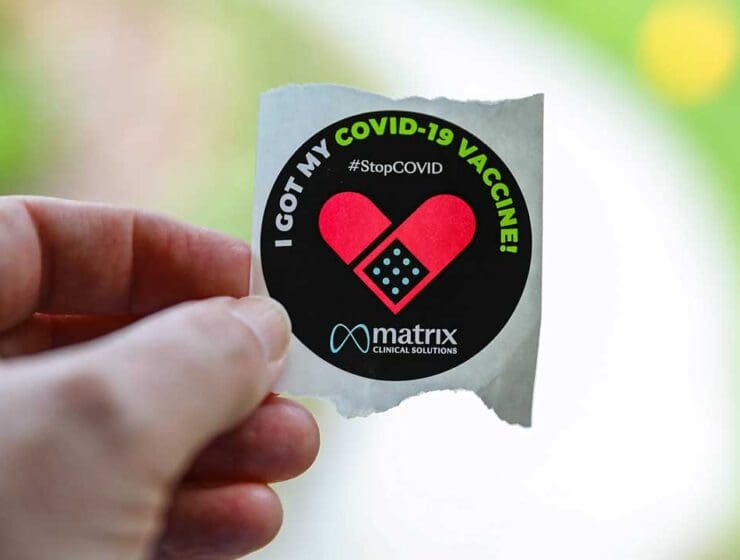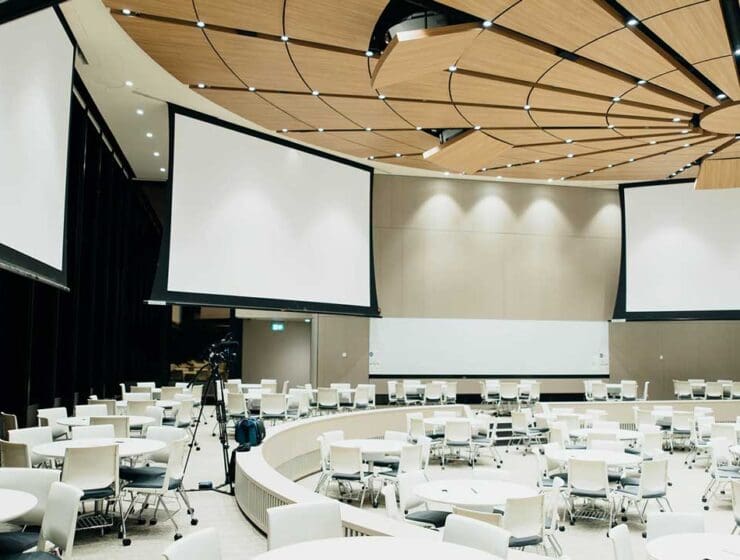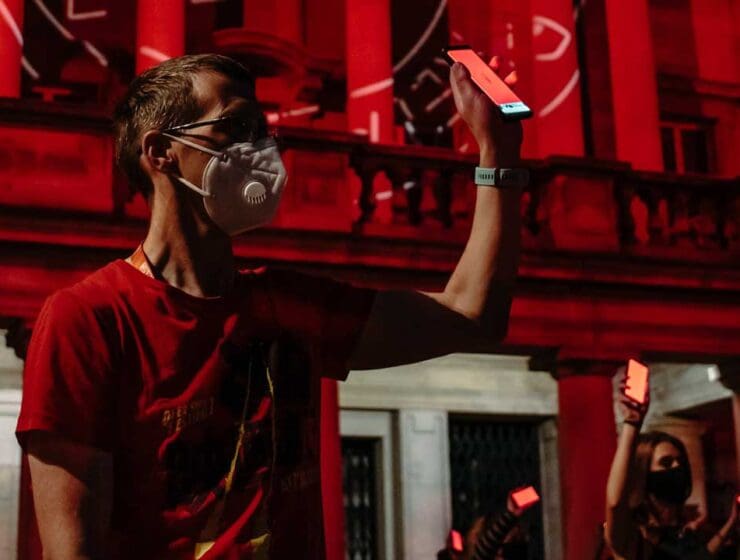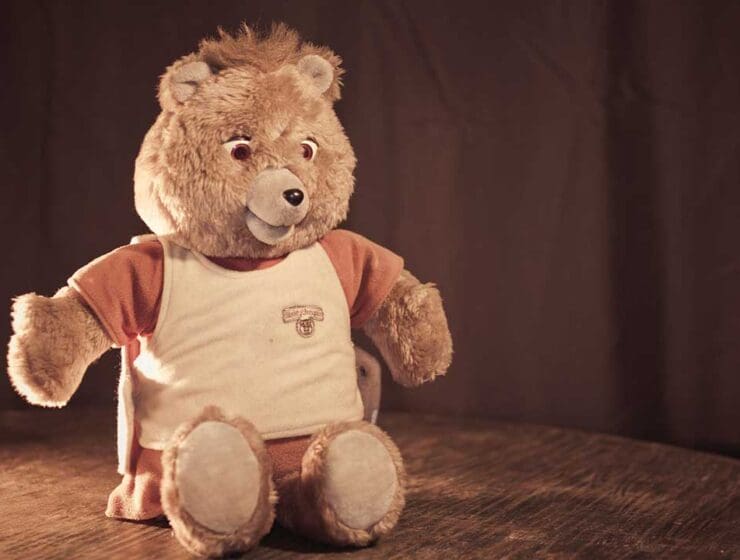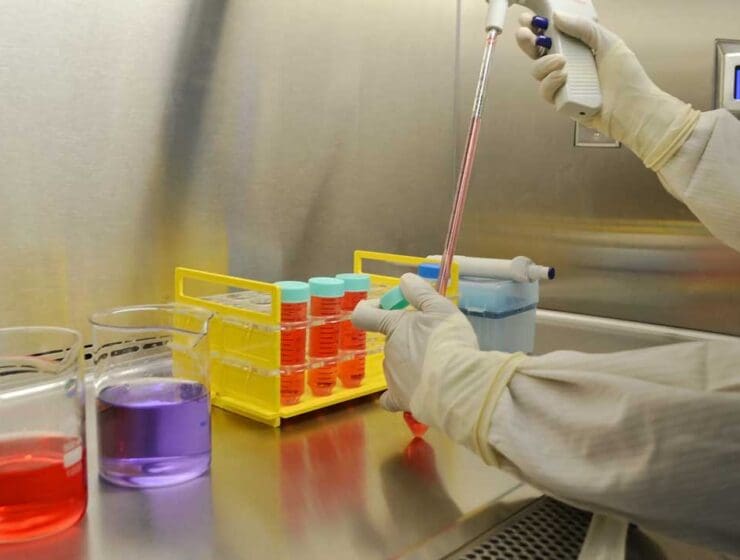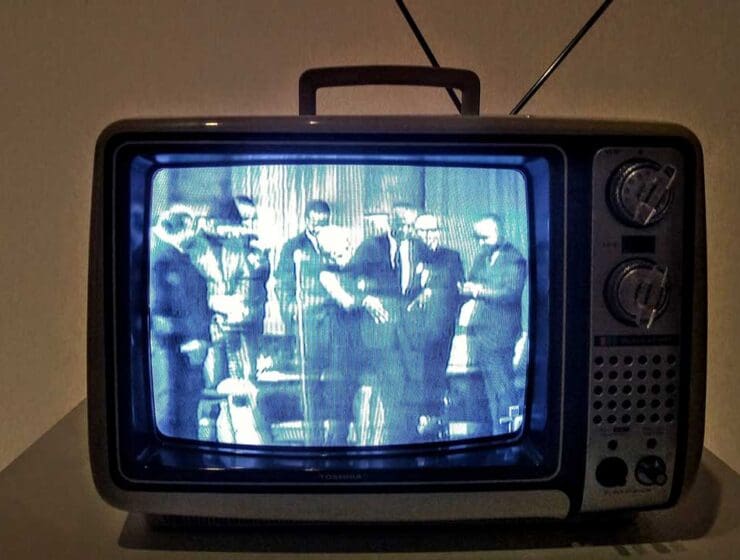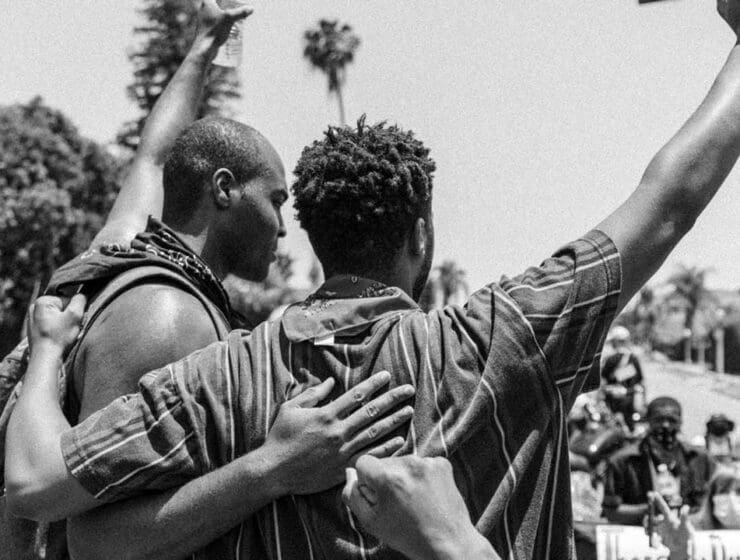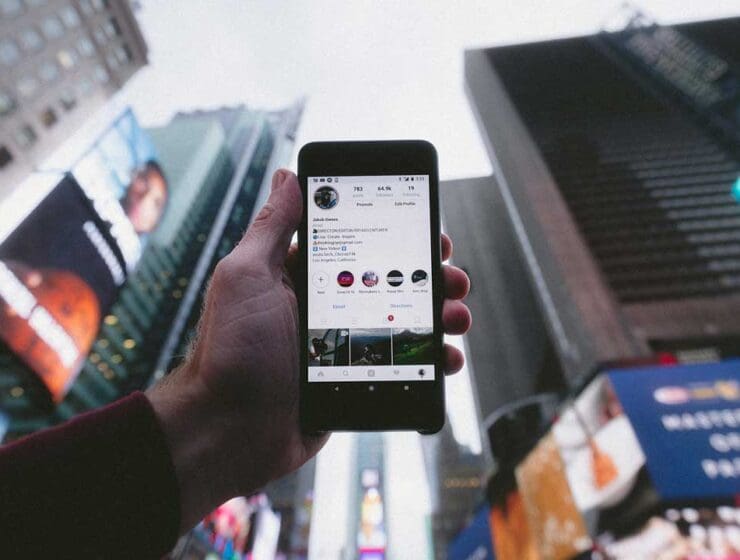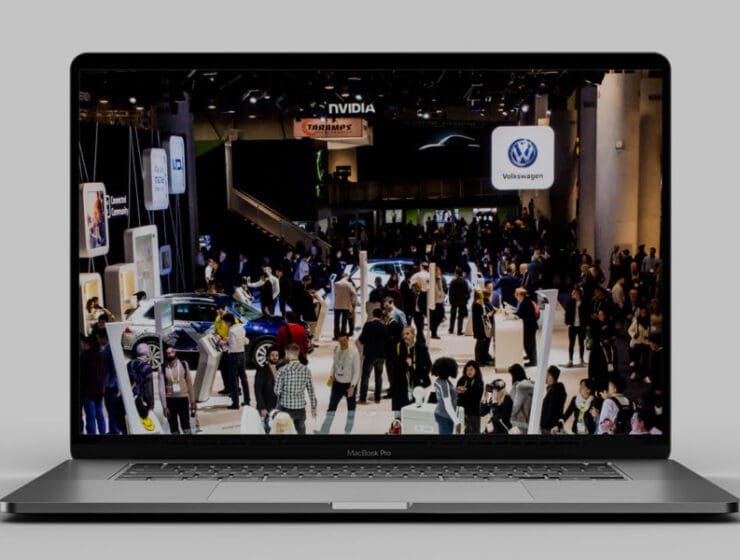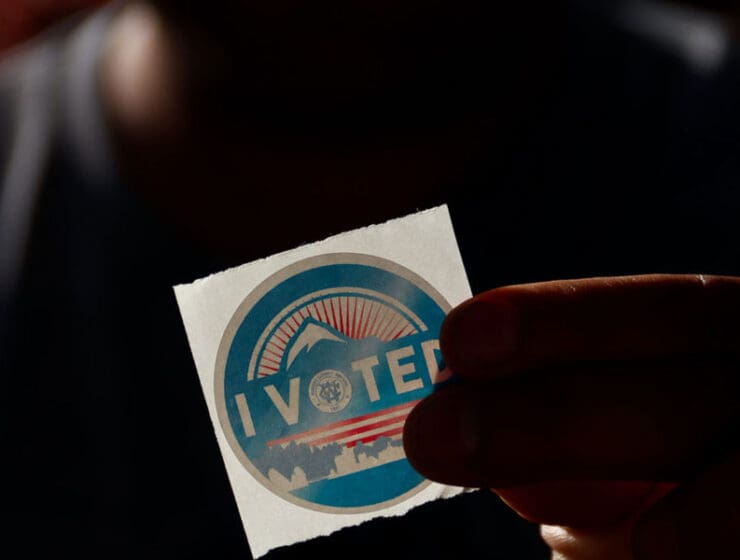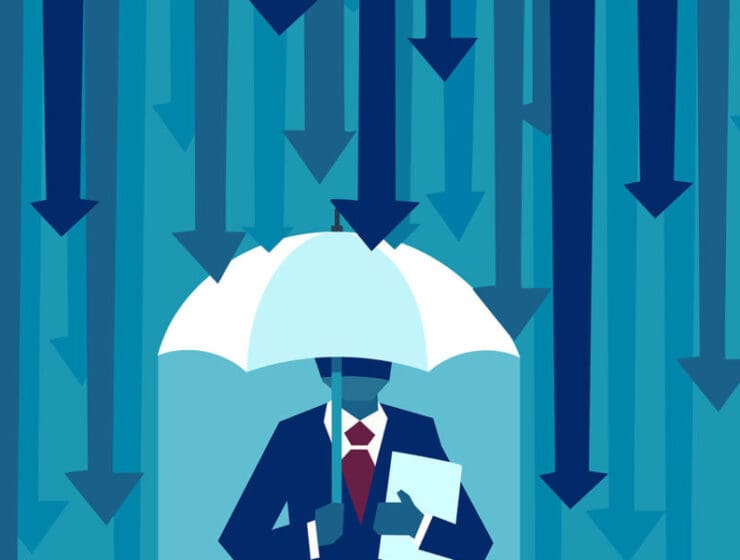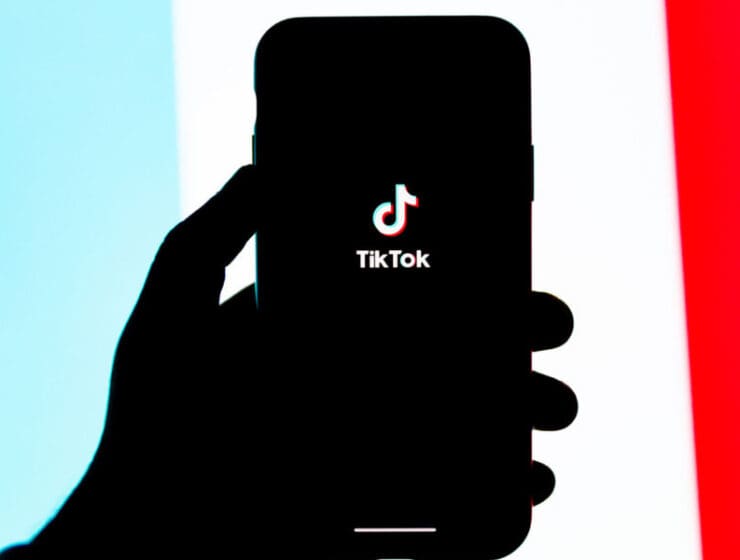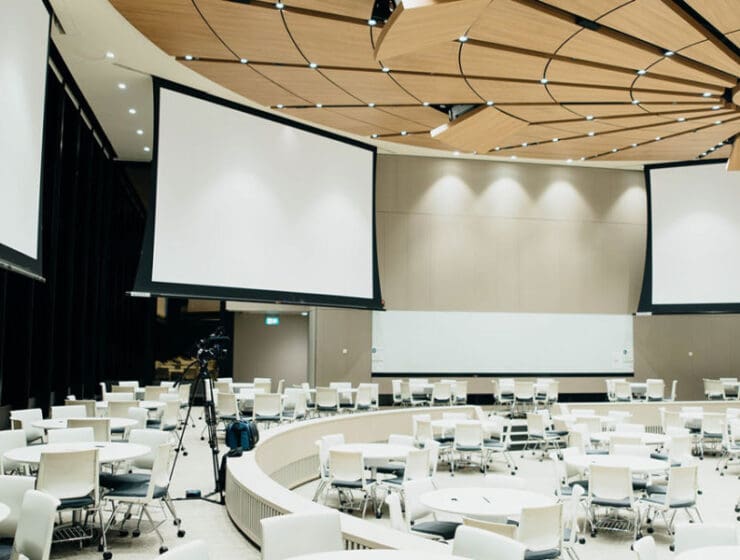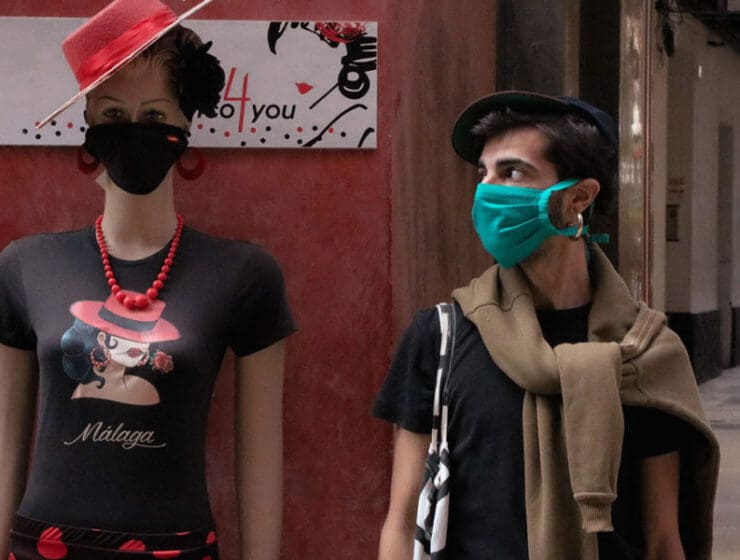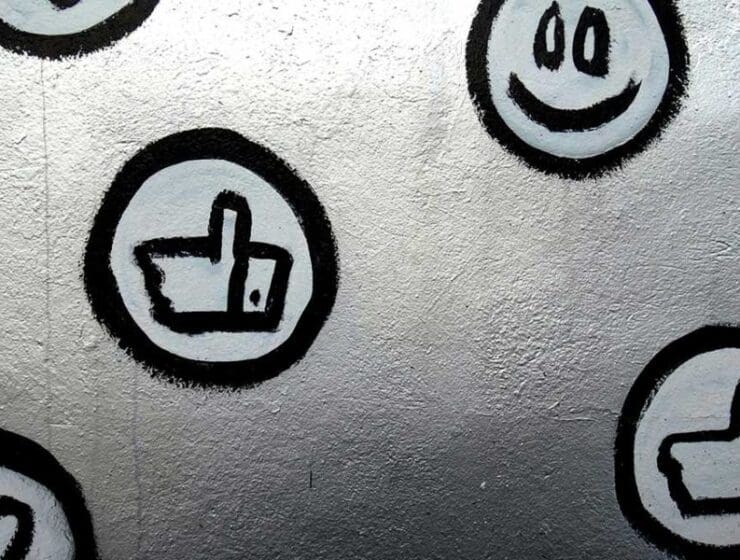Lorenzo Thione is the Managing Director at Gaingels. A venture investment group focused on investing and supporting LGBT+ founded/led startups. He recently sat down with Nick Woodford, content manager at Anzu, to talk about the ground-breaking work that Gaingels do.
_Editorial
Brand Purpose (capital ‘p’) offers the WHY a brand does what it does. It goes beyond profits, offering a reason for being that’s grounded in humanity. And, as many brands have recognized this past 18 months, that Purpose can be a guiding and stabilizing light in dark times.
The online shopping experience on many websites can feel like being dropped in the middle of a warehouse — especially for something like grocery where there are thousands of products to choose from.
When creating new content, video or otherwise, one of the first steps you should take is defining and researching your audience.
In the past few years, brands have started to embrace the LGBTQ+ community, often changing their logos to feature rainbow colours during Pride months to show their support. Having worked in the media ecosystem, I noticed that there were still things that needed to change for brands to show their support further.
In this report, you will discover the six main themes that emerged from this summit, explaining how marketers should approach the fast-growing mobile space.
COVID-19 vaccines have been rolling out across the U.S. for six months now, but the real work for vaccination campaigns is just beginning. As supply eclipses demand, all eyes are turning to Americans who have expressed hesitancy or outright resistance to being vaccinated against COVID-19.
On June 24-26, 2005, evangelist Billy Graham held his “last crusade” at Flushing Meadows Corona Park, speaking to approximately 242,000 people. Today, from Graham’s birthplace Charlotte, NC, Gale Bonnell of Adams Outdoor Advertising looks back at the connection between the legendary preacher and out of home media.
There’s a lot to be said for being a working mom or dad. But one thing that’s not often talked about is the lessons of parenthood that have an uncanny application to marketers and business leaders.
Even though people are getting more used to the idea of shopping online, the fact that they can’t see, touch, or try the actual product is a big purchase stopper. Luckily, eCommerce companies and their marketing teams have product videos to help them with that.
In 2021, in perhaps the most dynamic ad marketplace in the history of advertising, advocating a data-led, tech-enabled, omnichannel approach is not enough to keep you nimble, ready to compete and win.
In the latest instalment of our series exploring corporate social responsibility, we speak to Paul Sigaloff, who leads Verizon Media’s business in ANZ, India and South East Asia.
Sometimes finding inspiration starts with knowing your audience intimately. Here, Carmela Soares, Creative Strategist at Facebook Creative Shop, outlines the importance of resonating with individuals on an emotional level.
Wooing Generation Z can be a tough sell. Educated, dedicated and increasingly conscious of their consumption habits, they can be a tricky cohort to engage in authentic ways. Unless of course, you’re New Zealander Iyia Liu, a serial entrepreneur who has shown again and again she knows what Gen Z wants.
To many, it feels as though the skies have parted and the world around us is opening up. Our worlds have been ‘unlocked’ and it has us ready for what’s next. In fact, the first place we’ve gone is to our computers…“Get me the heck out of here!”
Everyone is talking about the end of the cookie and what kinds of targeting will survive in the aftermath. Many continually debate that context is or isn’t the answer to this loss of signal.
The Upfronts returned to a virtual format in 2021. But even compared to 2020, we saw some differences this year. First and foremost, streaming is a much bigger part of deals this year than it ever has been in the past.
Carriers and OEMs have spent decades investing in innovations that delight consumers and enhance the ways we use our phones, discover new things, make decisions and purchases.
You would never think about doing your job without ensuring you’re fully prepared for what’s in front of you. And yet, time and again, many people continue to wing it when it comes to one of the few areas that can immediately derail projects, reputations, even careers.
Audiences rediscovered their love for TV in a big way last year, specifically its more flexible digital incarnation. At the pandemic peak, CTV consumption soared by 160% globally and almost half of the consumers admitted to heavier use.
“Synergy.” “Leverage.” “Paradigm shift.” Why do people talk like this at work? Here are 20 words and phrases to cut from your work vocabulary.
Everything You Need To Know About Customer Engagement in 2021, all in one report. Download The Participation Economy presented by Braze.
The checkout flow is easily the most crucial phase of any online business. But, with customer expectations for an easy purchase journey at its peak, the process is not always smooth-sailing.
The digital advertising industry is a space of constant evolution. From the emergence of smartphones to the adoption of Connected TV, to the laser-focus on data privacy, ongoing developments continue to transform online advertising.
In the 20 years since FirmDecisions first made media contract compliance auditing an integral part of many leading brands’ system of checks and balances, much has changed in the marketing ecosystem.
During the spring of 2020, when Covid-19 lockdowns spread across the U.S., numerous advertisers on Facebook, Amazon and elsewhere paused their campaigns.
Data technology companies and brands are scrambling to protect income streams and create workarounds for campaign targeting to ensure paid marketing success within the new constraints.
Over the last year shopping, consumption, and engagement patterns have drastically changed when it comes to how people interact with brands. But, one thing remains to be constant, participation with people, where they are, is key for brand connection.
The Out of Home industry took some big blows from the pandemic, but it is recovering fast. Along the way, we have learned some interesting things over the last year.
Business travel expenses will be scrutinized like never before as companies weigh them against the cost of videoconferencing (which is virtually free). Mainstays like privacy and comfort will remain important, but new values like flexibility have emerged.
AW360 sat down with Brad Ralph, Senior Director of Content Development at Getty Images, to talk about his experience as the founder of iStock.com and share some of his hard-earned insights as to how small businesses can keep in step with copyright laws and protect creators’ rights.
While digital ad spend may be rising, overall marketing budgets are still contracting, albeit at a slower rate than last year, meaning marketers need to account for every penny spent and prove they are delivering real value.
Innovation remains at the heart of Webex, and today they are launching an all-new Webex Suite that is built on the most recent learnings on remote work realities the global pandemic taught us.
For brands that manage a loyalty program in the travel space, now is the time to conduct a thorough review of both your loyalty program and your loyalty strategies to ensure you can make the most of the recovery phase.
Say a company has successfully identified a problem or opportunity. What is the next step?
I started work at Little Colossus (owned by UnLtd) at the start of 2020 and I officially became the General Manager in July. MOOD tea is the first brand we have launched as Little Colossus.
There’s something to be said for giving your target market a say in the development process, from a marketing perspective or otherwise.
The Digital Transformation taking over today’s world is an inevitable revolution that will keep growing as tech advances.
Why follow one track only when you can combine the best of all worlds to maximize returns. This is how you build a real B2B brand that you can actually take to the bank.
Hardhat is an agency that works to marry the best of creativity with an understanding of the ins and outs of human behaviour. Here, Co-Founder Dan Monheit gives us an insight into how he uses psychology to fuel creative output.
Cultural inclusion is gaining prominence in the advertising industry and in recent years it has taken great strides forward. Here, we talk to four agency heads across Australia and New Zealand, who have been bringing indigenous voices and cultural values further into the mainstream advertising and media environment.
There are good reasons that content has long been considered the rightful king. When well placed and targeted, it has the primal ability to connect and spark consumer engagement, both short and longer-term.
Think back to the long-ago pre-pandemic days of 2019, when engineering leaders and hiring managers brainstormed the best ways to create supportive, inspiring team cultures.
As we look ahead to a new wave of winners and losers – yet to be decided in the post-Covid flux – businesses that walk the line between digital and real worlds may well come off the best.
Every decade or so there is a public service ad campaign so iconic that it defines the time in which it was made. The new ‘It’s Up To You’ campaign, aims to educate Americans about the COVID-19 vaccines and will almost certainly be the defining campaign for the 2020s.
Streaming TV advertising brings new opportunities to brands as first-party data and the digital infrastructure enables more advanced targeting and measurement capabilities. These capabilities give marketers more control over their campaigns resulting in better ROI.
In this era of inclusion, which has become synonymous with diversity, brands need to show what really matters. In the LGBTQ+ community, it’s important to connect through imagery that feels real and avoids using stereotypes as shorthand.
Working with a nonprofit can be a powerful way for a brand or corporation to express its values around civic or social issues. Let’s digest what it really means to work with a nonprofit and how to make the most of it.
While the increased difficulty in tracking consumers across the internet will pose challenges, these changes will also open new opportunities and ways to create a better user experience.
Here we distill the key insights from OpenX’s roundtable discussion at Advertising Week 2020 and put the spotlight on a broad panel of experts across the media and marketing landscape.
This report focuses on the dramatic changes we are experience in the TV and advertising-supported video on-demand (AVOD) landscape in 2020.
Despite the pandemic, the benefits of attending conferences – albeit virtually or in person – have never really changed. Here, industry trade show regular, Josh Paterson of Grammatik Agency explores the benefits of the future of events and how a hybrid experience will be the way forward in the months ahead.
Advertising has long been about three things: audience, placement, and creative. But creative, the third path through these woods remains the road less traveled. This is a huge missed opportunity. Creativity is the most important factor in campaign performance.
The business world is moving towards sustainability. The benefits are clear: you can help the planet and help your business. In fact, one-third of consumers prefer sustainable brands according to a report by Unilever.
When did you start caring about workers forming unions and striking for better pay? How old were you when any alarm set in over the potential for monopolization of information and access to it became a critical concern in your mind?
A key goal for any business is brand loyalty. While one-off sales are always positive, it’s a loyal customer base and repeat business that truly sets a brand up for success.
Reactive marketing is the effort by brands to quickly produce content that responds to a current event, talking point or faux pas in a clever or thought-provoking way. It has roots in the newsprint advertising industry, but social media has been instrumental in its meteoric rise.
Digital transformation represents a fundamental change in how an organization delivers value to its customers. It’s the latest in a line of data-driven, tech-enabled shifts that have fundamentally changed modern marketing as we know it.
I can’t compare and contrast what it was like to lead a company before and during the pandemic, but I can share three lessons I learned during this time that my team and I will carry forward into the future.
The way brands excite consumers may have changed due to the physical, in-person limitations of the pandemic, but it doesn’t mean people aren’t looking for ways to recreate the experiences they had with their favourites pre-COVID-19.
Competition in healthcare grows daily, with the digital marketplace more congested than ever before. Delivering cut-through in this space requires a strong brand, a robust marketing strategy and a class-leading customer experience.
If 2020 was the year of upheaval, 2021 is the year of progression. Businesses and marketers need to be pushing forward. Now is the time to dominate your industry and tackle influence, attention and profits.
Ads.txt, created in the summer of 2017 by the IAB to help publishers exert more control over their advertising inventory, and Sellers.json, released in 2019 by the IAB for buyers, are both well-intentioned and technologically well-designed.
A recent Fortune article examined some of the eye-popping statistics surrounding the growth in eCommerce in 2020. Even as retailers across the world dramatically increase their online sales, Amazon remains the 800-pound gorilla in the marketplace.
Seeing marketing as the sole arbiter of video content or framing video as the new broadcast equivalent to meet the demands of CTV misses the point.
In this report, you will discover the six main themes that emerged from this summit, explaining how marketers should approach the fast-growing mobile space.
Nicola Sturgeon is probably rubbing her hands together in glee right now. She’s pumped up, ready to take on Westminster with what she will no doubt argue is a renewed mandate for a second referendum.
B2B marketers need to think ahead in order find their direction and navigate tomorrow’s privacy-compliant cookieless world.
You will never know whether or not your business is thriving or heading in the right direction unless you measure the effectiveness of the strategies you implement. Key performance indicators or KPIs are essential in measuring your organization’s efforts in achieving its goals.
Another year brings another year of new products. Once upon a time, queuing for the newest game console or camping outside a retail store for a pair of celebrity designer trainers was an unusual event.
New Zealand-founded agency Special Group has recently taken out Campaign UK’s Global Creative & Independent Agency of the Year award. Founder, Tony Bradbourne, reveals some of the secrets of its internationally renowned creative.
Ahead of AWAPAC 2021, Advertising Week presents a Q&A with Brett Armstrong, General Manager, Global Business Solutions, TikTok ANZ
How much “privacy” is actually in Google’s privacy sandbox? I fear a further oligopolization of the internet if no countermeasures are taken.
Global competition is fierce. And, for new businesses, it can be intimidating. Whether your business succeeds or fails comes down to profitability (the amount of money remaining after all business expenses are paid). That’s the only way to build a sustainable business.
There is still only a very limited number of brands that use older people in their content for products and services that aren’t age-related. Brands are often too quick to assume that younger demographics are the only ones engaging with digital.
Gen Z is an enormous business prize: this group is the biggest generation ever, estimated at 30% of the global population. As we know, they are almost constantly Fortniting, TikToking and Netflixing their way through the world.
In today’s multichannel world, marketing campaigns are more complex than ever before. To ensure their message is being seen by the right audience, marketers have to engage consumers across multiple channels and digital media.
Consumers are devoting their time to an ever-more diverse portfolio of devices and formats, so it can be tempting to assume that traditional formats must have lost some of their shine; mass digitization during the pandemic has only fueled these assumptions.
While the last thing the advertising industry needs is another buzzword, re-orienting thinking toward a ‘strategic content partner’ approach embraces the best of in-house and long-term partnerships.
As COVID-19 lockdowns begin to ease, global digital immersion has become impossible to ignore – and social media has quickly become the lifeblood of every brand’s marketing strategy.
2020 marked a trying time for us all. As we inch closer to the pandemic’s end, can we look back and call out the inspiring moments associated with it too?
As a channel, email continues to evolve and become smarter. But at the same time, deliverability challenges still plague senders and prevent emails from reaching subscribers’ inboxes.
Subscriptions have surged in popularity during the COVID crisis, with two in five people in the UK signing up to new subscriptions since it began and at least 57% having one, up 10% on last year.
For many Gen Xers and Boomers like myself, Friends was a cultural touchstone; it reflected who we were as twenty- and thirty-somethings before it signed off in 2004.
The ad tech industry has spent the past year closely monitoring and digesting updates around Apple’s SKAdNetwork and Google Chrome’s Privacy Sandbox, knowing that both carry dramatic implications for how our industry will gather consumer data.
A combination of the roadmap out of lockdown and an effective vaccine rollout means UK consumers are starting to envisage a more positive future.
A half-century ago, small-town startup Daktronics made an electronic wrestling scoreboard that became synonymous with the sport. Now Daktronics (NASDAQ: DAKT) lights up the world.
Here are 5 significant commerce media opportunities that you can try with your clients – all with multiple important benefits.
Performance marketing has always belonged to the lower funnel, to the end of the customer journey, to programmatic and search — or so the thinking goes.
To better understand the rise of intent, B2B marketers need to think about their core function: listening to what their prospective buyers are looking for.
Ahead of Vevo’s AWAdvance event on 25 May, 2021, we sat down with Robert Velez, Director of US Multicultural & LATAM Sales at Vevo to discuss the LATAM market and Vevo’s unique and growing position within it.
As consumers emerge from lockdown – some blinking and tentative and others in a mad dash – marketers need to remember it won’t be like it was BC (Before Covid).
Content marketing is, however, the most sustainable way to grow demand and a loyal audience. If you’re in need of immediate results, content marketing is not for you. But if you’re after long-term success and growing your audience base, you’ve found your match.
Over the years we’ve heard lots of debate about the viability of email. As social media steamrolled onto the scene, many people in the industry even wrote email off as “dead,” proclaiming that social would make email irrelevant, especially for younger generations.
Optimism, properly channeled, is a powerful catalyst for change. And if you can retain your sense of optimism even amidst a pandemic, you possess a marketer’s most essential quality.
If the ad industry wants to resolve its privacy and data-tracking issues, it should take a cue from retail.
Earth Day has been and gone but sustainability need not be hinged on just one day in the year. While it serves as a conscious reminder to us all just how important it is to protect our planet, consumers are more aware than ever of how the decisions they make impact the world we live in.
#WorkFromHomeLife has affected us all… so why are businesses still relying on imagery of moms homeschooling while dads work?
With economic conditions and key indicators on the rise, B2B marketers are taking stock of their business to take advantage of what should be a very strong 2021.
There is nothing like a pandemic lockdown to induce some much-needed introspection. For some, it manifested as a deeper focus on quality family time, rediscovering the outdoors, or picking up a new hobby.
The digital advertising industry has been operating at the expense of user privacy for a long time. As an industry, we need to make some fundamental changes to redress the balance.
There are plenty of lessons to take to heart from 2020. Both the pandemic and the social justice movements ignited by the death of George Floyd in the U.S. have cracked open the protective shields many brands had been hiding behind.
A decade of “roaring 20s” celebration is possible, but it’s not here yet. If the needs of the smallest firms are not perfectly aligned with the needs of the largest—their recovery won’t be, either.
Social media has been the dominant media channel for around a decade, and for good reason. The sheer size of social media platforms’ audiences (Facebook alone counted 2.7bn users) and the rich data they collect have created an advertising bonanza.
In a panel by Advertising Week, presented by Magnite, we get an inside look into the billion-dollar growth of the company Pluto, which was recently acquired by ViacomCBS, how Roku navigates viewer and brand relationships, and how CTV opens a world of opportunities for live sports advertising.
Among the industries devastated by the global pandemic, perhaps none have been as thoroughly ravaged as the live events space. In a single year, the live events industry took a more than $30 billion hit in terms of lost revenue, and the crisis isn’t over yet.
The title of this article, Meaner and Nicer, expresses the realities of starting and owning a business. It reflects the advancing and changing environment in which my firm was built, as well as the marketplace’s reaction to the evolution in needs, attitudes and world views that span two decades.
The German market has a reputation for being a little slower to develop than other parts of the world, with a longer adoption cycle for new products/features, hesitancy to work with international players not based in Germany, and sensitivity around data privacy.
Need help mastering a complicated recipe? Inspiration for up-cycling old furniture? Tips on how to homeschool while working a full-time job? Advice for re-entering the world as it slowly starts to open back up? There’s an online community for that on Reddit.
Brands are increasingly turning to programmatic delivery to bolster their efficiency, but to survive the death of the cookie they’ll need a better grasp of contextual targeting.
By now, most of us have begun reckoning with the coming reality. Cookies are indeed going away, identifying customers is undoubtedly getting harder, and companies like Google and Apple are not coming to save us.
The TV landscape is in a state of transformation, as is the advertising that powers it. Applying our industry’s standard “shiny new object” lens to what’s happening in TV right now does the reality of the opportunity a disservice. Here’s why.
Tourism analysts see hopeful signs in theme park bookings, airline traffic, and more. Leisure travel is recovering first, ahead of business trips, experts say.
Work culture matters. Now more than ever. Who you are and what you stand for matters to people who work at your company and buy your products.
Covid-19 exposed African American beauty salons and barbershop owners to more than a virus: It exposed how important these businesses are to the Black community.
App-less augmented reality may be an inevitability. But with WebAR comes both new opportunities and new challenges.
While every part of the business community has been affected by ever-changing regulations, closing and re-openings, as well as health and safety guidelines, impacts to the small business community have been significant.
Working as part of an agency roster is tough at times, but it can equally be exciting. At Dog, we’ve had over 20 years of practicing how to navigate and get the best out of cross-agency partnerships and learned a lot along the way.
In advertising we’re having our Fujiwhara moment, where the privacy wave is intermingling with the targeted advertising ecosystem, creating a confusing picture for the advertiser.
Not much is guaranteed in a post-Covid world, but we’ll tell you one thing: Gen Z wants action.
Investing in stocks, I recently found out, is hard. The silver lining to my failed day trading career is that I realized there are some striking overlaps between investing and brand strategy.
It’s not often a news story unites so many diverse figures and groups across society. But from Boris Johnson, Jeremy Corbyn and Prince William to football pundits, ex-players, current managers and rival football fans across the land, the world spoke up together this week against the newly proposed European Super League. And the answer was categorically, no.
Marketers and publishers are burning the midnight oil to figure out how to keep their revenue from pancaking as we move into the post-cookie/IDFA reality, especially after Google’s recent unsurprising “bombshell.”
Nurturing and sustaining culture and its values are important for any leadership team, but 2021 will be a uniquely critical time to support employees, as the definition of “company culture” continues to shift.
From the Mad Men era to the creative zeitgeist of today, the ad industry has experienced quite the transformation. The industry as a whole, the work it produces, and its clients are frequently studied and discussed.
Athletes, musicians, influencers, even business people of different stripes have curated their images in such ways that their successes can be viewed through the lens of successful marketing.
In this piece, we’ll take a look at some of the latest statistics on video marketing for 2021. By the end, you’ll hopefully see all that video can do for your business.
It’s a crucial part of operating any business that you understand your target audience. They’re the people that will keep coming back, offering avenues for free promotion and reassurance your products and services are appealing.
Consumer data is the latest battleground for companies to win dominance over their competition. They are clamoring to build honeypots of data that can be leveraged for their own benefit and purposes.
McKinsey estimates that in the US, the pandemic is likely to be influential in our lives until at least Q3 or Q4 2021, which means we have at least 6 months where our proof of health matters significantly to our ability to move freely.
Paradigm shifts are hard. When you’re used to doing something a certain way, realizing that you can do it in a completely different way (and get similar results) is really hard to grasp.
The events of last year forced many retail companies to reevaluate their messaging, planned social content, and even the diversity of their boardrooms.
Modern advertising is a data-driven practice. So as new regulations and browser policies take hold, many fear a coming data crunch.
When President Joe Biden visited Pittsburgh to pitch his infrastructure bill, environmentalists urged him to “Go Big” on Covid recovery. Their media platform: billboards.
Aiming to stand out from the crowd and surpass consumers’ expectations, CTV advertisers have to be allied with publishers and very savvy at applying innovative advertising techniques, like frequency capping, competitive ad separation, and deduplication.
Marketers have become obsessed with zero-party data — and rightfully so, as it’s the “holy grail” of consumer information. Savvy marketers use zero-party data to improve the personalization of their brand communications and, ultimately, to deepen their relationships with customers — a high priority these days.
In my 20+ year marketing career, I have never encountered a product or service category that offers a more intriguing challenge than cannabis, and I seriously doubt I will encounter another.
Over the past year, digital marketplaces have crammed years’ worth of growth into just weeks. And while Amazon remains the biggest ecommerce player, the rapid acceleration of online shopping has produced several winners, Walmart.com and Instacart among them.
Social media plays a very important role for businesses in almost every industry. It offers them several benefits from expanding their reach, to building a community and dozens of others. It gives you instant access to your customers and helps keep them engaged with your company.
Google’s recent announcement that it won’t support user-level identifiers in its ecosystem, is just the latest step in its plans to change how consumers are tracked online.
The fact that the vast majority of audio content is not easily accessible or discoverable makes you wonder how much this has held audio back as a medium?
Culture is what differentiates us from the other living creatures on earth. Learning how to communicate with others is a social process regardless of the channel.
It’s the curious nature of humanity, when these x-in-a-lifetime events arise, to look downwards and backwards, at our dashboards, in our rearview mirrors. But eventually, we realize we must look through the windshield and, once again, beyond the hood and to the horizon.
In a blog post, a Google leader stated that, once cookies are phased out, “we will not build alternate identifiers to track individuals as they browse across the web, nor will we use them in our products.”
In theory, high shopping cart abandonment rates should reveal to eCommerce retailers that something is not working. However, online shopping carts are a feature that modern customers are utilizing quite differently than originally intended.
With the success of mass vaccination programs, the end of the pandemic feels more insight than ever before—and the return of in-person public life seems imminent.
In a move that slaps several large DSPs and data management companies in the face, Google is making it clear that on their properties, people can only be targeted in aggregate.
While there is still much uncertainty, how can businesses unaccustomed to virtual-only events ensure that those planned for 2021 will go off without a hitch?
John McMahon, Cedric Pech, Jeremy Duggan. Familiar? Probably not. But they are the rock stars of selling in fast-paced software unicorns; businesses such as BladeLogic, BMC, Ariba, Parametric Technology Corporation (PTC),
Engineers knit together to create highly orchestrated agile teams, meeting together for daily standups, code review and collaborations, all of which must be approached differently in a remote setting.
It’s not news to anyone in advertising that user-generated content (UGC) can be harnessed to develop effective ad creative.
The looming end of the third-party cookie has pitched the marketing industry into crisis mode. Advertisers and agencies are well aware that the data they collect and the third-party audiences they rely on will change in the near future.
The pandemic has proved a major catalyst for boosting data capability, but one misconception is still holding back progress: the belief that data maturity follows a linear path.
Like any other part of the communications landscape, barter agencies have had to adapt tactics and strategies to keep pace with these larger shifts—and some have done better than others.
The supermarket sector has remained front and centre during the pandemic, and 2020 proved to be a critical time for supermarket brands to stay in front of consumers.
During 2020 and 2021, we’ve seen nostalgia everywhere. It makes sense, right? There’s no better time to pine for the past and relive happy memories than when we’re stuck at home during lockdown. Nostalgia has made its way into every walk of life, from our wardrobes to our Instagram feeds.
Customers are the lifeblood of every business. That is why it is important to put a modern strategy in place to keep them happy. In this modern-day and age, many businesses consider automating their processes and one of the aspects that they are focusing on is customer communication.
In a digital-first world shouldn’t your digital experience be completely cohesive with your brand? I explored this recently in a webinar called For Tech’s Sake: Where Does Brand Sit In Tech Obsessed Digital Marketing and that led to an interesting conversation with Dom Boyd, MD of Insights and Offer at Kantar UK.
Whether it’s farmers, stockbrokers, sports team executives, or pilots, people and things perform better when data, algorithms, and science guide them.
To align with new habits under lockdown, budgets have been shifted into more mobile-friendly digital media. Traditional channels have taken a hit. But consumers still value traditional ads, and brands would be unwise to assume they’ve become stale.
While “data-driven insights” has been a buzz term for years, it received heightened focus in 2020 amidst the pandemic and as companies began to measure customer sentiment more frequently.
Since my previous story for AWMoms last year, the pandemic brought us to “Plan C”. (Spoiler alert- it hasn’t been horrible.)
With all the pressure to make an impact quickly, founders spend an incredible amount of time on the design of their slides. Less consideration, however, is usually spent on the words on the slide. That’s a mistake, especially when you only have 170 seconds.
While the pandemic undoubtedly did a great deal of damage, many categories are starting to see an uptick in digital ad spend and user acquisition and cost per click rates are starting to slowly rise again.
It’s clear that brands need to work on authenticity, but that can be easier said than done when you’re promoting a business on social media. The bar is high, and distrust is the default setting for most media users.
With 5.4 million women losing their jobs since the pandemic hit, it’s not good enough to pat women on the back and provide words of encouragement about change and support. Businesses need to provide real opportunities to help women get back on track and progress in their careers.
Apolo Ohno, America’s most decorated winter Olympian, chats with world champion Olympic wrestler J’den Cox and 23-time Paralympic medalist swimmer Jessica Long about how mental health and social injustice are paramount to elite athletes.
Necessity may be the mother of all invention, but it’s friction that gives birth to billion-dollar tech markets. The app economy is one of the most innovative markets out there, and yet friction in new app discovery is stymying its growth.
In this guide, we suggest which marketing tools and insights will help to increase downloads, keep your users engaged, and ready your newly successful app for an influx of traffic.
With many of today’s consumers opting to shop online and Amazon’s vast inventory and quick logistical services, there is a clear appetite for brands to claim a stake and sell. But, what do brands need to know to do this right?
We know that half of the digital ad spend is impacted negatively by fraud. The industry has remained tolerant of fraud, which impacts the smallest to largest media outlets. In fact, Facebook announced that it deleted 4.5 billion fake accounts in the first nine months of 2020 alone.
Wake up. Eat breakfast. Get ready for work. Check email. Respond to requests. Do the job you were assigned. Finish. Eat. Relax. Repeat.
Impression-based selling and automated transactions have been hot topics in the broadcast TV industry for years. Unfortunately, traditional approaches rule today’s buys. 95% of local spot TV transactions are still completed with manual, traditional workflows.
While the future of retail remains unclear, there’s no denying that more changes are on the horizon. By accepting that things won’t go back to how they were before the pandemic, retail leaders can stay agile and ready to meet the needs of both customers and employees.
This announcement further cements Google’s position to lead with a transparent and privacy-first approach to advertising within its Chrome ecosystem and products. It also reshapes the competitive landscape for data companies moving forward.
While it’s disappointing that festivals and concerts haven’t been able to attempt hosting events in-person amid the pandemic, it’s important to remember the struggles and lessons that various sports teams have learned throughout the process and how they’re essentially paving the way for other industries to successfully commence again.
AWMoms are women focused on creating conversations, increasing collaborations and supporting actionable initiatives which will help find real solutions to parenting issues in the workplace.
Consumer spending in China could more than double over the next 10 years, according to Morgan Stanley. But Chinese consumers are already buoying retailers that offer compelling products.
In order to reach audiences with something stronger than a numerical probability, advertisers are going to have to look for entirely new ways to connect with individual consumers.
The impact COVID-19 had on business rendered agencies’ strategic plans obsolete and disrupted their clients’ pre-existing marketing and branding roadmaps. After spending the past year scrambling for new business and adjusting to remote work, agencies finally have a little breathing room.
This past year has forced me as a founder and CEO to redefine several constructs I used to regard as dogma. Take the concept of wealth: in the traditional sense, wealth is an abundance of money or earthly possessions.
TV advertising and offline media budgets have yet to change much. The advertising budgets certainly haven’t fully transitioned into the digital arena as quickly as they ought to be to match consumer behavior migration.
Global online video views are at an all-time high and rising 100% every year. The widespread accessibility of high-speed internet allows users to watch live and on-demand videos more than ever before.
The privacy bubble is starting to burst and advertisers and marketers alike are quickly pivoting their efforts to include Audio OOH technology in their marketing strategies to reach customers in a privacy-conscious world.
As Global Head, Vice President, and General Manager of eCommerce at Lenovo, Ajit Sivadasan is focused on managing the customer’s experience with the brand as well as the purchasing experience on Lenovo.com. We sat down with Ajit to ask him about Lenovo’s experience over the past year and what challenges and opportunities lie ahead.
While Google and Facebook’s dominance has long seemed insurmountable, the past two years have seen the rise of a third major online advertising player.
Branding is the way a business owner communicates his or her business’ identity to customers. It’s beyond what you sell; it’s your mission, company values, aesthetic, and tone of voice. It’s essentially how customers emotionally experience your company.
The past 12 months have been a personal and professional rollercoaster for all Americans, and brands have been doing their best to ride the ups and downs with them.
We sat down with Jennifer Allen, COO of handsome, to discuss the rise of digital creative during COVID, the dangers of ‘too much’ digital, and the present and future of omnichannel.
Video, by its nature, is highly subjective. Ten people might watch the same video and have varying perceptions of what it is about, which makes it hard to ensure safety and resonance at scale.
When considering the ways marketplaces can generate revenue, there are three basic options available to operators: subscription fees for membership (for buyers or sellers, or both), transaction fees (charged to buyers or sellers, or both), or advertising/media fees.
With such a fine line between authenticity and performative activism, how can we help ensure brands approach these important conversations in a way that moves the needle forward, not only for business success but for the progression of the movement?
Back in March 2020 when the pandemic first forced businesses to shift to WFH and brands were examining how they talked to customers that demonstrated empathy, clients started asking a lot larger purpose-related, brand strategy-type questions.
The parochial view of Amazon is they’re a high-volume store that struggles with thin profit margins. Water cooler stock experts marvel at its high stock price and crow about its measly profits. Here’s some free advice: don’t listen to the arm-chair experts.
In marketing, the more precisely you can define your audience, the more accurately you can predict whether that audience contains your best prospects – and the more quickly you can use that knowledge to find and convert more customers. And one key tool that helps you do that is segmentation.
To provide a good customer experience across multiple channels, banks and credit unions will need to think more about bringing channels together, and a good first step is through marketing automation.
Last year, on International Women’s Day 2020, a female-led team at AnalogFolk launched BigUp.AI – a digital language tool that gives women the confidence to get ahead in their career by helping them express their strengths with impact instead of downplaying them.
I believe there are five trends that have either emerged or will continue to emerge as we move into the post-COVID era which can inform how we craft content and target advertising, designed to engage potential guests.
Programmatic advertising is a lot like Formula 1 auto racing: The technology is powerful, but in order to actually win races, it needs to be driven by seasoned experts.
A balanced media mix will always be important to advertising. But driving business growth relies on facts you can trust, and our research underlines just how powerful TV continues to be.
Looking into what 2021 holds for marketers, brands have a timely opportunity to embrace the growth of digital events–with a focus on fans as a keystone component.
What can brands and marketers do to benefit consumers during this crucial period of their lives? Our friends at Healthline Media have created their 2021 Fitness Forecast to answer that very question.
Over the course of the tumultuous year, we observed that content publisher partners experienced material year-over-year growth despite it all, a trend that validated their very emergence as key contributors in the affiliate marketing channel.
I’m no Paula Radcliffe, as anyone who has seen me run can testify, but we’ve all been on a marathon over the past twelve months and I, for one, think the finishing line is in sight.
In years past, diversity, equity and inclusion were causally applied in the experiential marketing industry. The social events of 2020, however, have created a spirit of intentionality.
Going into 2021, it’s time for brands to reset and reclaim control of their destinies. 2020’s stop-gap solutions and quick pivots might have kept the lights on. But did they position your business for the long-term road ahead?
Since Google announced the phase-out of the third-party tracking cookie last year, the digital ad industry has been scrambling to prepare for a change in how business is done.
Amanda Glasgow, creative director EMEA at digital consultancy Appnovation, explores the digital tactics that beauty brands need to stand out in a cutthroat sphere.
Clubhouse, a new invite-only “drop-in audio chat” app available on iOS, is gaining momentum. Launched in March 2020, Clubhouse is the latest platform making brand marketers take notice of the power of audio as a communication channel.
Despite relations between advertisers and publishers having their moments, both parties go above and beyond in their troubleshooting techniques to make them work.
It’s Black History Month and the traditional time for brands to roll out their marketing efforts and key into the demographic around this space.
It’s no secret that third-party cookies are going away. We read headlines daily about the approaching cookie-apocalypse.
2021 on paper is daunting. But could 2021 be the year of rebirth? Q1 will bring Apple’s diminishment of IDFA. We’re also wrestling with the best way to soften the impact of Google’s 2022 third-party cookie deprecation on Chrome.
Marketing is an area of your business where you should never be satisfied with current results. There are virtually always new angles, methods, and trends you can implement to get the most out of your advertising spend.
Today more than ever, organizations need to put their customers at the center of their marketing programs and build plans based on a deep understanding of where and how they can deliver the most value.
Agencies of all shapes and sizes were disrupted as the pandemic plunged our industry into the unpredicted territory. And while the experience has been humbling for us all, I’d argue it has gone a long way to showcase the strengths of the independent agency model and how they work with their partners.
Good branding is the foundation for all your marketing success, which is why so much effort goes into it. It’s important that your branding is memorable and constant across all channels and platforms, with one report finding that consistent branding increases revenue by 33%.
The words businesses are using are under a microscope. And that means brands need to make sure that what they’re saying – and how they’re saying it – stands up to scrutiny. So how do you make sure your words are fit for purpose, no matter what 2021 throws at us?
Browsers are blocking third-party cookies in the name of privacy, but this alone won’t protect personal data within the digital advertising ecosystem. There is a far better and simpler solution for achieving this goal, in the form of contextual targeting.
Now that 2021 is well underway, consumers everywhere are seeking knowledge and practical advice on how to better themselves and their health after a rocky year under quarantine and stress.
We spoke with Melissa Tischler of global creative consultancy Lippincott about her Principles for Driving Innovation-Led Growth, why brand is an essential input to innovation and how prioritizing innovation today can unlock growth for tomorrow.
5 experience principles that are fundamental to how we can design and reimagine brand experiences that work at every stage of the consumer lifecycle, for 2021 and beyond.
With increasing awareness around mental health for Gen Z and Millennials, brands have a distinct opportunity and also a responsibility to connect with younger consumers by more accurately reflecting the realities of how and why these generations prioritize their mental wellbeing.
Throughout all of these events, the impact on the daily lives of Americans was profound. The compounding crises altered how we work, how we learn, how we entertain ourselves and even how we think about social issues.
In this article, we will focus on high-powered messaging, although frequent messaging is rather straight forward as businesses engage in frequent, cross-channel advertising to catch the consumer near or at the point of consumption.
In this article, we will focus on high-powered messaging, although frequent messaging is rather straight forward as businesses engage in frequent, cross-channel advertising to catch the consumer near or at the point of consumption.
Retailers are ready to make the most of limited in-store options and online shopping this year. And while the pandemic has undoubtedly accelerated the dramatic transformation of the consumer retail market, the trends that have been driving this transformation have actually been around for years.
We know it as consumers as well as marketers: the COVID pandemic precipitated profound social, economic, technological and behavioral changes in 2020.
As brands seek to continue transforming at speed, they require a new set of tools to build a structure that will withstand shake-ups in the digital landscape.
The pandemic turned work-life on its head. We’re caught in the tumbling load of a never-ending workday, pinballing between Zoom and Slack, duking it out with the family for WiFi, dishes piling up around us in our office…er…kitchen, and just trying to hold it together while we just. take. a. minute. to. remember. what. day. it. is.
For decades, a TV served as the focal point in millions of living spaces; if you didn’t have one, you were the exception, not the rule. Fast-forward to the present day, and it’s clear that a lot has changed.
The CNN town hall in Milwaukee gave President Biden a chance to “speak to the American people,” said a Marquette University professor. When Biden arrived in Milwaukee (February 16) billboards spoke directly to the President.
Of all the common themes in science fiction – spaceship battles, alien invasions, colonized planets – the most tenacious might be the question of what happens when machines become more like people.
Last year was the year we lived vicariously through social media. Cooped up indoors, it was our portal to the outside world, removing the miles between us and our friends, family and colleagues.
Years from now, when historians and cultural anthropologists look back at the 2021 Super Bowl ads, what will they glean about our culture today?
From theme parks to fast food outlets or reality TV shows – there’s a long history of ideas succeeding in the US before they find their way across the pond to European shores.
Though Facebook and Apple have been taking jabs at each other for years, the past two years seems to have been an acceleration toward an unavoidable crash. One that the industry has been nervously watching.
Data: something digital marketers cling to and that’s universally relied on to make decisions. A silver lining of 2020 is that access to data has allowed marketers to make quick and informed decisions with each twist and turn.
Within the advertising world, there is an inherent stigma associated with targeting older consumers. Too often marketers believe their next job lies in reaching young, hip consumers rather than focusing on the customers that are going to translate to the most sales today.
If I was to predict 2030, I would have predicted that machines would be helping us make some of the most important decisions of our lives, what to buy, where to go, who to meet, and more.
The Super Bowl can be a huge performance-driver, which begs the question why would anyone invest the big marketing spend if it’s not going to go all the way to the end zone?
To effectively validate and enhance ROI, marketers must assess real actions rather than relying purely on basic metrics, such as click-through rates (CTRs). Achieving this will mean ensuring analysis produces robust and reliable insight by standardization, holistic and adding agility to their measurement approach.
Strong relationships are built on trust. That’s true between your friends, it’s true between your neighbors, and it’s true in your businesses. It’s also true when we talk about the relationship between buyer and seller, who often come together as strangers.
About a year ago, the world was forced indoors: feeling scared, confused, and downright anxious, the abundance of streaming services available for download provided a sort of escapism to a fraught America.
It’s no surprise that last year we saw a spike in pandemic-related products, such as hand sanitizer and face masks, with the majority of top 10 product searches being related to these protective items and panic buying peaking in July of 2020.
While the nation battles COVID-19, and vaccination rollouts seemingly remain disjointed and chaotic, it is likely that more eyes than ever will be watching the Super Bowl from their homes this year.
The publishing industry is undergoing yet another period of dramatic upheaval as new policy shifts among the tech giants further limit the ability of publishers to target ads using third-party data or identifiers.
Whether it is setting aside lunchtime breaks from work to watch a critical news update or gathering around a favourite series for light relief, watching TV has become a bigger ‘household activity’ than ever before.
Times of crisis lead to spikes in innovation and enterprise. And times of global crisis lead to global changes.
The Super Bowl is the single biggest entertainment event in the United States, and has always been a cornerstone strategy for brands to reach a massive audience in a brand-safe environment (wardrobe malfunctions notwithstanding).
Scholars say the unblinking eyes of the Gatsby billboard observed the morality of the Roaring Twenties, perhaps a vigil of the Almighty. The omnipresent billboard also symbolized something more earthly: our deep cultural connection with out of home advertising.
Ever been able to recite a YouTube pre-roll ad or found yourself annoyed at a poorly timed pop-up? Then you know how powerful a presence advertising is across our digital experience.
Concept testing, whether it’s for early ideas or for alpha and beta testing of new products and devices, can help companies avoid expensive failures and maximize new revenue streams.
The B2B customer journey is a long and complex one. Often a conversion is preceded by emails, catalog views, searches and site visits, before the first phone call or meeting.
Last year’s Super Bowl was the least-watched in a decade. In fact, Super Bowl audiences have been shrinking every season since 2015. And this year, the shadow of COVID-19 looms large. Social distancing necessitates a low-key stadium audience and means there will be far fewer viewing parties watching the game.
Amanda Follit knows the effect of hearing the wrong words at the wrong time: “Many moons ago, I was put off anything to do with computers by just one teacher, and that changed the path I took for a while,” she recalls.
Apple’s Identifier for Advertisers (IDFA) is under fire as two new complaints have been filed from the European privacy campaign. The company’s setting of the IDFA breaches regional privacy laws on digital tracking because iOS users are not asked for their consent for the identifier’s initial storage.
Getting customers for your brand’s products or services can be tough and staying in your target audience’s mind can be an even bigger challenge. However, the rewards are greater as well. Brands want to be the first business they think of when they’re looking for a product or service.
Technology is transforming the creative space. Wripple is the first agency services platform that lets you find expert, on-demand teams. We interviewed Co-Founder Ray Samuels for more insight into the mission to make it easier to find and hire talent and what this means for space in 2021.
The word “unprecedented” has been used a lot to describe 2020. Only a few weeks into 2021 and it’s seeping into the new year as well. Yet, we’ve learned over the last several months that as people we are resilient and determined to find hope and optimism through it all.
2021 marketing predictions are two a penny. As an alternative, I suggest you create a calendar for what you want to achieve, then do it.
Customer relationship management systems (CRMs) are great for collecting and organizing data. But, what are we doing with all this data?
2021 is a new landscape for sales and marketing, and each team has a lot to learn from the other.
Our insatiable desire for instant gratification is now being met more often than not. So what does that mean for 2021?
In its truest form, SPO was designed to bring advertisers and publishers closer together, remove the noise, and pull back the curtain that historically formed between the two.
Our industry has changed and the seemingly separate worlds of digital and linear TV are colliding. As this convergence continues to become more commonplace and the viewing experience preferred by consumers rapidly evolves, the benefits of services have become impossible for traditional broadcasters to ignore.
We are taking a stance on issues like never before. But what is really driving our actions? The answer isn’t always clear. Understanding hidden, personal biases and how they motivate people has been at the root of marketing and advertising for decades.
Brand awareness has been at the forefront of priorities for digital marketing managers the last couple of years and has become even more important amidst obvious market changes. So what exactly does it take to achieve this?
As we approach 2021 with little confidence in things returning to normal any time soon, is it time for brands to help add some much-needed friction back into people’s lives?
2020 was a year of challenges, but also, a year of learnings… sometimes the hard way. Suddenly, everything in our agencies changed, and we had to learn how to communicate, brainstorm, chat, present, produce… everything we used to do, but we had to learn how to do in a completely different way, and from a distance—remotely.
Right now the economy is pretty much shattered, the weather is appalling and we’re all high-security imprisoned in our homes. What’s to look forward to?
Below is a ‘how-to guide’ of practical tips to reduce experiential’s environmental impact. Whether you decide to implement them all or begin with just a few, every step taken is a valuable one.
Shifts in the environment have naturally created shifts in our psychology and behaviour, and it’s made the common phrase “‘you want what you can’t have” seem ever more poignant.
Google and Facebook may have prioritized advertising tools for small businesses, but there’s no reason why other publishers can’t prove their worth to this vast set of buyers.
E-commerce took on even greater importance in 2020, so why are advertisers still focused on Facebook and Google?
As augmented reality experiences have become more mainstream, they have also become more and more robust, looking and feeling realistic. But until recently, they have been largely confined to a single-user experience.
Our dynamic market creates opportunities for businesses to grow faster, but only if they’re ready to capitalize on our new market realities.
No one could have imagined back in last December what 2020 would turn out to be in the world of esports and gaming.
First, it was the cookie. Then the IDFA. Both Google and Apple are, in their typically outsized manner, accelerating industry trends.
Brand advertisers are understandably anxious about brand safety but there’s actually some good news on that front.
The internet has always represented an amalgamation of anonymous activity and authenticated users, with the balance of power between these two diametric views of online behavior swinging dramatically throughout the digital age.
Businesses and consumers alike are finding ways to adapt and stay resilient during these unprecedented times.
Screen time can trigger migraines and tension-based headaches. Dr. Charisse Litchman explains how to stop them before they start.
What if you could increase the accuracy of your performance data, reduce wasted cost and reinvest the savings in brand-building initiatives?
As enterprise-scale consumer brands face the disruptions caused by COVID-19, their needs eclipse and transcend the marketing use case for CDP technology.
Misinformation and disinformation ran rampant in a year marked by a global pandemic, a U.S. election, racial unrest, climate disasters and an economic downturn.
I’d like to take you back to about ten years ago—when advertising was still “easy,” and you asked your agency to create a TVC. Both production and media budgets were solid.
With every new phase of the TV landscape’s evolution over the past decade, traditional capabilities have fallen closer in line with digital media.
Going into 2021, if you’re not considering modifications to the media strategy you laid out a year ago, you’re likely neglecting new opportunities.
If you lead a modern business, you know that your online presence is a crucial component of your financial success.
A few weeks ago, Pantone announced the 2021 colors of the year. Yellow and Gray. Two colors that in ordinary times are fine, not striking.
25% of CMOs will adopt zero-party data strategies in 2021. Why? Because they have to.
Collaboration comes in many forms and for the purposes of this discussion, we are going to focus on the benefits of collaborative marketing.
Companies across industries might be prone to disruption in the coming year, but the wheels will keep turning.
These are challenging times for producers in the FMCG arena. Although Covid has had a detrimental effect on some industries, it has also been very positive for others.
If there was ever an event that can benefit from using an all-digital format to make significant leaps forward, it’s CES. And there is no doubt that the best practices from CES 2021 will shape what the event will look like for years to come.
Let’s take a look at what we mean when we talk about the connection between elections and research technology (ResTech).
The words design and creativity are widely misunderstood. If you were to ask people what they first think of when hearing them, they might say painting or drawing.
The era of the standalone data management platform (DMP)—along with tech point solutions in general—is rapidly coming to an end. For a lot of brands that are hugely invested in their current tech stacks, this represents an unpleasant reality.
First and foremost, good memes often take a novel approach to media and typically break corporate creative norms. What’s produced by the average corporate design team is likely too polished and too reliant on thoroughly researched formulas to capture the right mood.
The most powerful takeaway was that the coronavirus is causing consumers to face a duality of competing thoughts.
The ability to quickly adapt has become a survival skill for digital advertising businesses, which have entered the most condensed innovation cycle ever.
While analytical tools to understand and fine-tune creative performance are becoming more readily available, many brands are slow to adopt them, often casting them aside as simply more tools, more tech, and yet another platform to learn.
While almost every corner of digital advertising has experienced change this year, CTV has certainly seen a notable uptick in investment, driven by consumer trends: 80 percent of U.S. households now stream video to a connected device.
Pre-pandemic, the events business was booming for publishers, with some seeing double-digit growth in sponsorships and attendance in recent years. The biggest problem for some was an overcrowded calendar. Now, the events space is reeling.
While it would be a big stretch to suggest that brands can fix society’s problems, who’s better suited than marketers to offer messages of reassurance—or even joy. To shift the conversation to what’s next and how we’ll get there, we’ll need brand leadership, rooted in something besides platitudes.
Our recent research revealed that 84% of consumers surveyed in the US and UK think their behaviours and habits have already changed for the foreseeable in the light of COVID-19, and these changes go beyond online shopping habits.
They are sick of it (it = all the things) but are making things happen. They are trying to figure out how to help themselves and the world all at the same time. They are frustrated but fierce, tired but tireless, fearful but powerful.
Panic about advertising technology has been in oversupply. Amid another COVID resurgence, there’s absolutely no sense of what the future holds for ad tech.
Blockchain technology has already created an online economy. What other applications can this revolutionary new innovation have in the world of gaming? Let’s look at exciting new developments in the future of the industry.
What if we told you that one of the most malicious online practices is utilizing the exact same “Gig-Economy” to grow and spread?
According to financeonline.com, the number of social media users is expected to increase to more than 4 billion by 2021. As social media continues to play a role in many companies’ digital marketing campaigns, here are seven crucial KPIs to look-out for in 2021.
For the third and final installment in our research series on consumer anxiety, we asked Americans about their holiday plans: How will they celebrate their traditions? Will they gather?
After a multi-billion-dollar avalanche of political attack ads — so off-putting that some voters turned off their TVs — a glimpse of humor appears in the Georgia runoff election.
As Americans firm and flip (and again firm) up their holiday plans, both in terms of activities at home and potential travel over holiday vacations, they’re doing so based on their personal perceptions of the virus and the threat it poses to their families and communities right now.
Helen Rose, head of insight and analytics at independent media agency the7stars, explores the role of empathy in driving gender awareness – for next-level brand campaigning.
Gaming technology is making waves in the advertising industry as a powerful production solution. Techniques previously reserved for video games promise to positively change the production playing field for brands, agencies and creative studios alike.
We are now at a point where technology is outpacing humanity.
2020 saw everything change, with the global health crisis largely eliminating live events and upending proven marketing techniques. With brands eager to reunite with customers, experiential marketing pivoted to help forge these important relationships now and into the future.
The gaming audience is larger, more diverse, and more nuanced than many realize. Gamers are multifaceted and oftentimes misunderstood.
The shift from physical to digital events is an unavoidable necessity in the current climate. Even pre-COVID there was a significant movement towards hybrid events, but the pandemic put a rocket up the entire industry when it comes to virtual.
Phil Schraeder, CEO at global technology and media company GumGum, explains why now is the time for the AI industry to examine its conscience and tackle bias from the inside-out.
Tracey Shirtcliff, founder and CEO of The Virtu Group, maker of the adtech tool Scopes, the scope of work and budget management tool that helps brands and agencies budget better-using data, is someone who can accurately be described as a serial entrepreneur.
Here’s one of my cardinal rules for media planning: the opportunity of a lifetime is only there during the lifetime of the opportunity. When it comes to maximizing the reach and efficiency of a media plan, those opportunities fly by at light speed.
Amid rising global privacy restrictions, accessing the data needed to understand consumer behaviour and serve content that breaks through has become increasingly tough; especially with third-party cookies facing stricter limitations.
Votes are expensive things to earn. It was neither Trump nor Biden who shone the clearest light on how to effectively market an election – it was New York Representative Alexandria Ocasio-Cortez, a.k.a. AOC.
The brand needed a suite of both product photography and lifestyle photography to be used across its website, social channels and PR campaigns. With no pre-existing assets, the Wonderhatch team had a clean slate to work from.
Samba TV’s CEO and Co-Founder discusses the many measurable findings facing television and streaming advertisers in a very uncommon year for the industry.
As part of your social media marketing efforts, you should be aware of the possibilities of mistakes that can damage your brand’s image. Taking steps towards prevention is always the best solution to protecting your brand in social media.
Today’s advertising triopoly is known — Facebook, Google, and most recently, Amazon. But a fourth player has remained inextricably linked to Facebook’s successes and position — Apple.
Our latest AWMoms Table Talk, Raising Good Humans, features Dr. Aliza Pressman of The Raising Good Humans Podcast in conversation with UWG’s Monique Nelson and Facebook’s Crystal Worthem.
For the August, 2020 AWMoms Table Talk, Heidi Levyn, Industry Manager, E-Commerce at Facebook speaks with Eve Rodsky, Author of Fair Play: A Game-Changing Solution For When You Have Too Much To Do (And More Life To Live)
Featuring Allan Thygesen (President , Americas, Google) Jim Farley (President & CEO, Ford Motor Company)…
Mary Hines, Chief Marketing Officer, U.S. Consumer Bank at Citi, will share her perspective on…
Lauren Weinberg, Square’s Head of Global Marketing, will share how a digital-first approach continues to…
The past year has significantly accelerated the shift to digital and cemented new consumer behaviors.…
Since COVID, the automotive industry has completely transformed. Trends that were once emerging, like buying…
Ford’s vision, to accelerate change by focusing on the data created outside the four doors…
As digital acceleration continues, auto shoppers are shifting what they buy, how they buy, and…
Hear directly from Chandreyi Davis, VP of Global Brand for Expedia Group, who will share…
Here’s a quick look into Google’s newest travel products and how we’re helping partners drive…
Hear from Julia Vander Ploeg, the SVP, Global Head of Digital & Technology at Hyatt…
The future of travel will be flexible, intentional and “up for grabs.” How can travel…
Hear from Sajal Kohli, Senior Partner and Head of Retail & CPG practices at McKinsey…
Hear from William White, SVP and CMO of Walmart U.S., about how the world’s leading…
As B2B buying evolves to become more digitally-driven and more decision-making becomes more democratized across…
Hear from Fara Howard, the Chief Marketing Officer of GoDaddy, on how GoDaddy is accelerating…
The past year has significantly accelerated the shift to ecommerce and created new consumer behaviors.…
The shift to digital cemented new buyer behaviors, particularly as the workforce became remote and…
To say the last 12 months have been challenging is an understatement. But as pragmatic optimists energized by ideas of “what’s next,” we’re drawn to the silver linings from the last year. As ravaging and upending as the pandemic has been, it has also illuminated consumer shifts that are already transforming the future of marketing.
In the last year, the pandemic has forced businesses to rethink everything. Companies have scrambled to figure out how — and even whether — to move forward.
Amid all of the past year’s challenges, brands showed up for consumers like never before, creating a blueprint for marketing that is even more customer focused.
Kids of all ages are no longer going to school, daycare, extra-curricular, or occupied by babysitters. While the family time and chance to grow alongside their children is appreciated, for many mothers it’s a 24-hour, 7 days-a-week job that has moms everywhere feeling the emotional and physical fatigue.
The lockdown has given non-parents a window into just how challenging juggling parenting and work can be. It may be physically and emotionally draining, yet we parents are managing. That’s what we do.
To celebrate Mother’s Day 2020, Advertising Week and Facebook joined forces for AWMoms Table Talk, featuring casual discussions between working mothers in the industry.
To celebrate Mother’s Day 2020, Advertising Week and Facebook joined forces for AWMoms Table Talk, featuring casual discussions between working mothers in the industry.
Stephanie Latham currently leads the Technology, Mobility & Connectivity Sales Teams at Facebook; her story for AWMoms is nothing short of a must-read.
My story is less of an example of successfully returning to the workplace and resuming a promising career, but more a story of successfully creating, accepting and thriving with “Plan B”.
Through the darkness of the pandemic, the idea of someday being able to tell our little boy, Wyatt, about the magic of his arrival is a thought that shines through.
AWMoms is a committee of moms supported by Advertising Week who work inside and outside of the home; for themselves, for organizations, corporations, and their families.
AWMoms is a committee of moms supported by Advertising Week who work inside and outside of the home; for themselves, for organizations, corporations, and their families.
AWMoms is a committee of moms supported by Advertising Week who work inside and outside of the home; for themselves, for organizations, corporations, and their families.
AWMoms is a committee of moms supported by Advertising Week who work inside and outside of the home; for themselves, for organizations, corporations, and their families.
AWMoms is a committee of moms supported by Advertising Week who work inside and outside of the home; for themselves, for organizations, corporations and their families.
AWMoms is a committee of moms supported by Advertising Week who work inside and outside of the home; for themselves, for organizations, corporations and their families.
AWMoms is a committee of moms supported by Advertising Week who work inside and outside of the home; for themselves, for organizations, corporations and for their families.
AWMoms is a committee of moms supported by Advertising Week who work inside and outside of the home; for themselves, for organizations, corporations and for their families.
AWMoms is a committee of moms supported by Advertising Week who work inside and outside of the home; for themselves, for organizations, corporations, and their families.
AWMoms is a committee of moms supported by Advertising Week who work inside and outside of the home; for themselves, for organizations, corporations and for their families.
As part of our ongoing commitment to telling the stories of industry mothers, we spoke with Carly Hertica. Carly has worked in development and fundraising for non-profits since graduating from Manhattan College in 2012.
As part of our ongoing commitment to telling the stories of industry mothers, we spoke with Gina Garrubbo, single mother and CEO of National Public Media.
AWMoms is a committee of moms supported by Advertising Week who work inside and outside of the home; for themselves, for organizations, corporations and for their families.
AWMoms is a committee of moms supported by Advertising Week who work inside and outside of the home; for themselves, for organizations, corporations and for their families.
As a valued partner, we appreciate you being a part of the Advertising Week family…
Moms in the workplace shape the future every day, whether it’s at their job or at home, growing future leaders and innovators. Working moms are more than just “mommy” or “boss”. They’re superheroes.
In the business world, Mother’s Day has become a time to critically reflect on the gap that still exists in creating a supportive culture and opportunity for working moms.
The discussion centers on Amtrak’s strategy to reposition train travel as a cutting-edge, tech-enabled experience.…
From Asia to Alaska, Gen Z loves to travel. With an emphasis on experiences over materialism and often lacking brand loyalty, Gen Z focuses on living life on its own terms.
You’ve successfully submitted your speaker release. Thank you. Please, take a moment to share your…
















